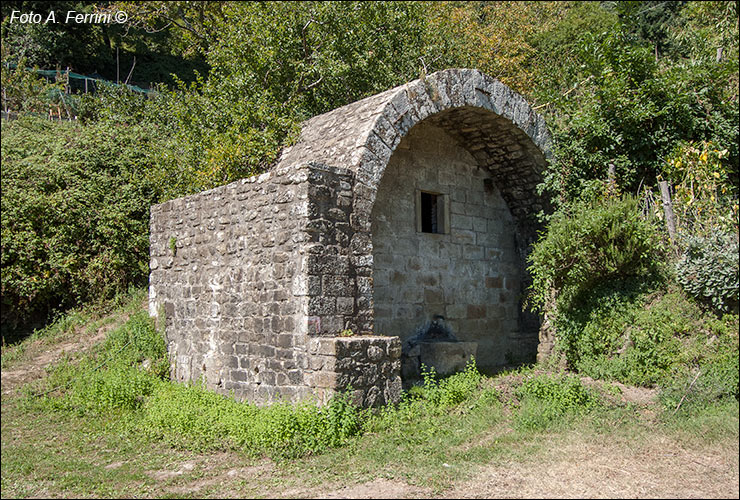Sulla via del ferro e della transumanza
itinerario sulle pendici sud Pratomagno da Pontenano al Passo della Crocina
Italiano
IN CAMMINO SU UNA VIA DELLA TRANSUMANZA 26
La Fonte Vecchia di Pontenano, all'inizio della strada che ci accingiamo a percorrere e che in tre chilometri ci condurrà al Passo della Crocina.
Secondo la tradizione locale, questa fonte monumentale è quella dell'antico castello. Sicuramente a quel tempo qui c'era una fonte, ma l'architettura che vediamo oggi non è medievale. Difficile datarla, ma è probabile risalga al periodo della rinascita del paese dopo la distruzione del castello nel 1426. Quindi, XVI o XVII secolo. Chiaramente è stata oggetto di vari restauri e modifiche. Si vede chiaramente che il muro esterno presenta un pietrame diverso tra la parte superiore e quella inferiore. È probabile che sia stato rialzato per irrobustire il grosso arco che fino ai primi decenni del Novecento non aveva la parete interna in posizione centrale come adesso, da una parte dell'arco. In questo modo la struttura disponeva di molto più spazio e oltre alla fonte poteva ospitare grandi lavatoi in grado di soddisfare le esigenze delle tante massaie del paese.
Dal medioevo a metà XX secolo, la strada che passa accanto alla Fonte Vecchia (oggi CAI 48), è stata la più importante via di comunicazione per Pontenano e faceva servizio alla Badia di Santa Trinita. Da qui si andava ad Arezzo e in Valdarno. Non a caso lungo questa strada, un centinaio di metri più in basso rispetto alla fonte, c'era uno spedale di cui rimangono ancora tracce di mura, ma sono nascoste dalle sterpaglie. La zona dove si trovava questa "struttura di accoglienza" è ancora chiamata con il nome Spedale.
The Fonte Vecchia di Pontenano, at the beginning of the road that we are about to travel and which in three kilometers will lead us to the Crocina Pass.
According to local tradition, this monumental source is that of the ancient castle. Surely there was a spring here at that time, but the architecture we see today is not medieval. It is difficult to date it, but it is likely that it dates back to the period of the town's rebirth after the destruction of the castle in 1426. Therefore, 16th or 17th century. It has clearly been the subject of various restorations and modifications. You can clearly see that the external wall has different stonework between the upper and lower parts. It is likely that it was raised to strengthen the large arch which until the first decades of the twentieth century did not have the internal wall in a central position as it does now, on one side of the arch. In this way the structure had much more space and in addition to the source it could accommodate large wash houses capable of satisfying the needs of the many housewives of the town.
From the Middle Ages to the mid-20th century, the road that passes next to the Fonte Vecchia (today CAI 48) was the most important communication route for Pontenano and served the Badia di Santa Trinita. From here we went to Arezzo and Valdarno. It is no coincidence that along this road, a hundred meters lower than the source, there was a hospital of which traces of the walls still remain, but they are hidden by undergrowth. The area where this "reception facility" was located is still called Spedale.



















































































